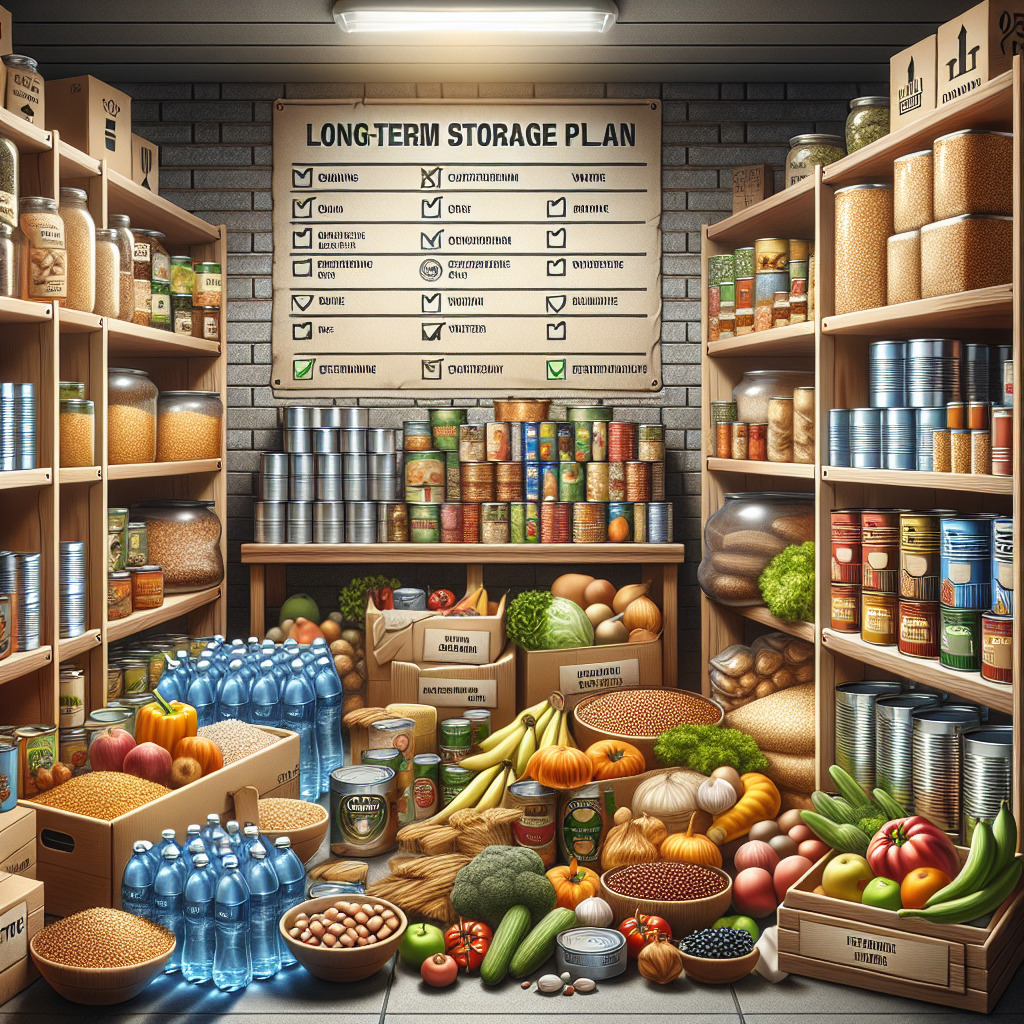Imagine a world where you never have to worry about running out of food. A world where you are prepared for any situation, whether it’s a natural disaster or economic crisis. In this article, we will explore the importance of creating a long-term food storage plan and provide you with valuable tips and insights on how to get started. With this plan in place, you can have peace of mind knowing that your family will be well-fed and taken care of, no matter what the future holds. So, let’s dive in and begin your journey towards securing a sustainable food supply for the long haul.
Determining your food storage needs
Assessing your storage space
Before you start building your long-term food storage plan, it’s essential to assess the available storage space in your home. Look at areas such as pantries, cupboards, shelves, and dedicated storage rooms. Consider the size and layout of these spaces as well as their accessibility. This evaluation will help you determine how much food you can fit and organize effectively.
Calculating the number of people to feed
The next step in creating your food storage plan is to calculate the number of people you need to feed. Consider the size of your household, including everyone who will depend on your food supply. Take into account family members, friends, or even neighbors who may rely on your resources during an emergency situation. This assessment ensures that you have enough food to sustain everyone over an extended period.
Considering dietary restrictions and preferences
When planning your food storage, it’s important to consider any dietary restrictions or preferences within your household. Take note of any allergies, intolerances, or specific dietary requirements that may affect the types of food you store. Additionally, consider the tastes and preferences of those you will be feeding. By accommodating everyone’s needs and preferences, you can ensure that your food storage plan is suitable for all individuals involved.
Choosing the right food items for your plan
Selecting non-perishable and shelf-stable foods
When selecting food items for your long-term storage plan, focus on non-perishable and shelf-stable options. These foods have a longer shelf life and can withstand varying temperature conditions. Look for items such as canned goods, dried fruits, nuts, grains, pasta, and powdered milk. Avoid foods that require refrigeration or have short expiration dates.
Including a variety of food groups
To maintain a balanced and nutritious diet, include a variety of food groups in your long-term food storage plan. Aim to incorporate carbohydrates, proteins, fats, fruits, and vegetables. This ensures that you have a well-rounded selection of foods to meet your nutritional needs in an emergency situation. Remember to choose items that cater to the dietary restrictions and preferences of those in your household.
Opting for foods with long shelf lives
When building your food storage plan, prioritize food items with long shelf lives. Look for products that have been specially processed or packaged for extended storage, such as freeze-dried and dehydrated goods. These foods can last for years and retain their nutritional value. Additionally, consider purchasing foods in bulk, as they often have a longer shelf life and can be more cost-effective.
Considering nutritional value
While focusing on long shelf lives and non-perishability, it’s crucial not to overlook the nutritional value of the foods you store. Opt for nutrient-dense options that provide essential vitamins, minerals, and macronutrients. Look for food items that offer a good balance of carbohydrates, proteins, and fats. By choosing nutritious foods, you can ensure that your stored supplies support health and well-being during an emergency.
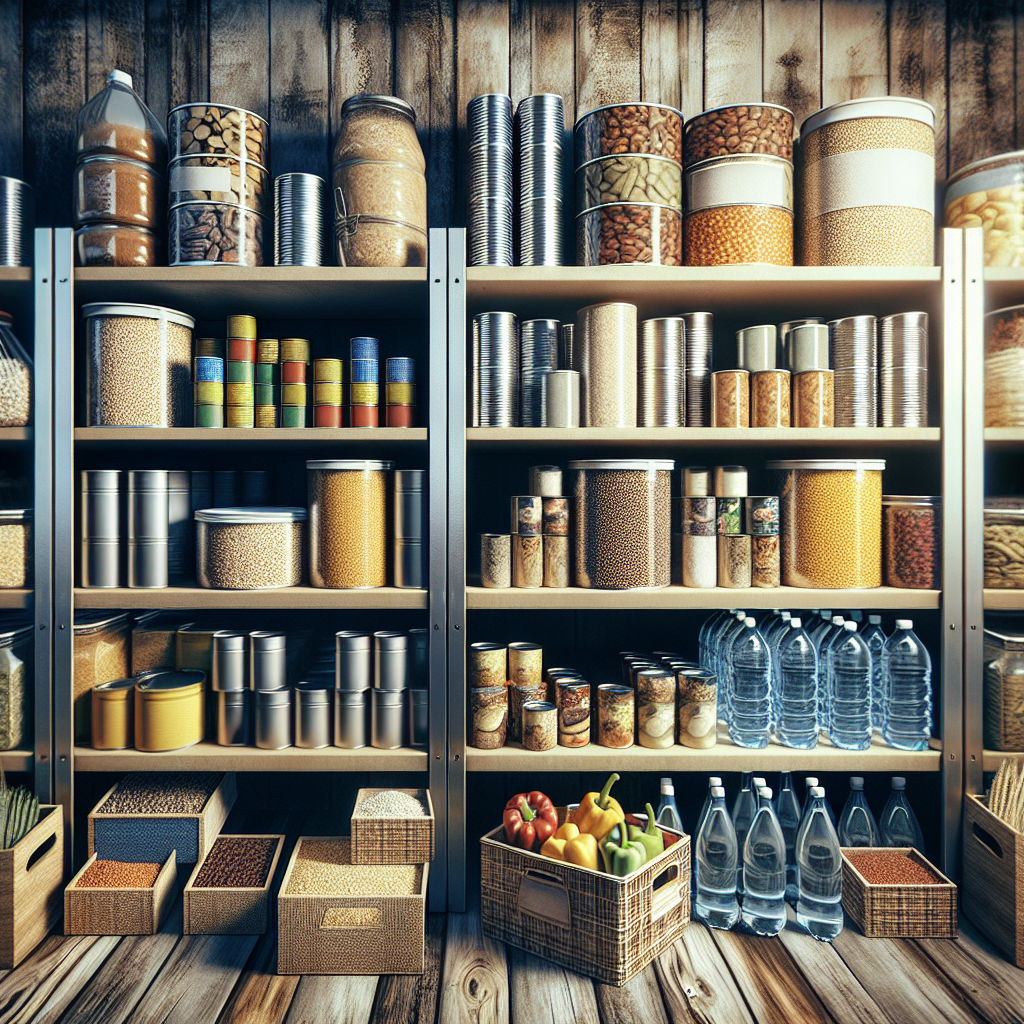
Calculating the quantity of food to store
Determining the recommended calorie intake
When calculating the quantity of food to store, it’s important to determine the recommended calorie intake per person per day. This will vary depending on factors such as age, gender, weight, and activity level. Multiply the recommended daily calorie intake by the number of days you want your food supply to last. This will give you a rough estimate of the total calorie count you need to plan for.
Factoring in the number of meals per day
Consider the number of meals you and your household typically consume each day. Most individuals have three main meals, while some may include snacks or additional meals throughout the day. Multiply the recommended calorie intake by the number of meals to determine the total amount of food required per day. This calculation will help you ensure that you have enough food to sustain everyone’s daily nutritional needs.
Accounting for individual needs and activity levels
Remember that individual needs and activity levels may vary within your household. Take into account factors such as age, gender, and physical exertion when assessing the quantity of food to store for each person. Children, pregnant or nursing women, and individuals with higher activity levels may require more calories and nutrients. Customizing your food storage plan to meet these specific needs will help ensure everyone’s well-being.
Considering the duration of storage
The duration of storage is another crucial factor to consider when calculating the quantity of food you need to store. Determine how long you want your food supply to last in an emergency scenario. Whether it’s a few weeks, months, or even longer, adjust your calculations accordingly to ensure you have an adequate stockpile. Keep in mind that certain food items may have shorter expiration dates and may need to be rotated or replenished more frequently.
Packaging and storing your food properly
Choosing appropriate storage containers
Proper packaging is essential to maintain the quality and longevity of your stored food. When selecting storage containers, opt for durable, airtight, and moisture-resistant options. Consider using food-grade plastic buckets with gamma-sealed lids or Mylar bags with oxygen absorbers. These containers provide optimal protection against moisture, pests, and oxygen, helping to preserve the freshness and nutritional value of your stored food.
Using proper packaging methods
When packaging your food items, employ proper techniques to ensure maximum shelf life. Use a vacuum sealer or oxygen absorbers to remove excess air from packaging, preventing spoilage and the growth of bacteria. Divide bulk food items into smaller, manageable portions to minimize exposure to air and moisture when opened. Label each package with the contents and date of packaging to maintain an organized inventory and aid in rotation.
Labeling and organizing your stored food
Maintaining an organized and well-documented inventory is crucial for an effective long-term food storage plan. Label each container or package with the contents and date of storage. This allows for easy identification and rotation of items to prevent spoilage. Consider creating a system that organizes food by category or meal type. Regularly review and update your inventory to ensure that you are aware of what you have and what needs to be replenished.
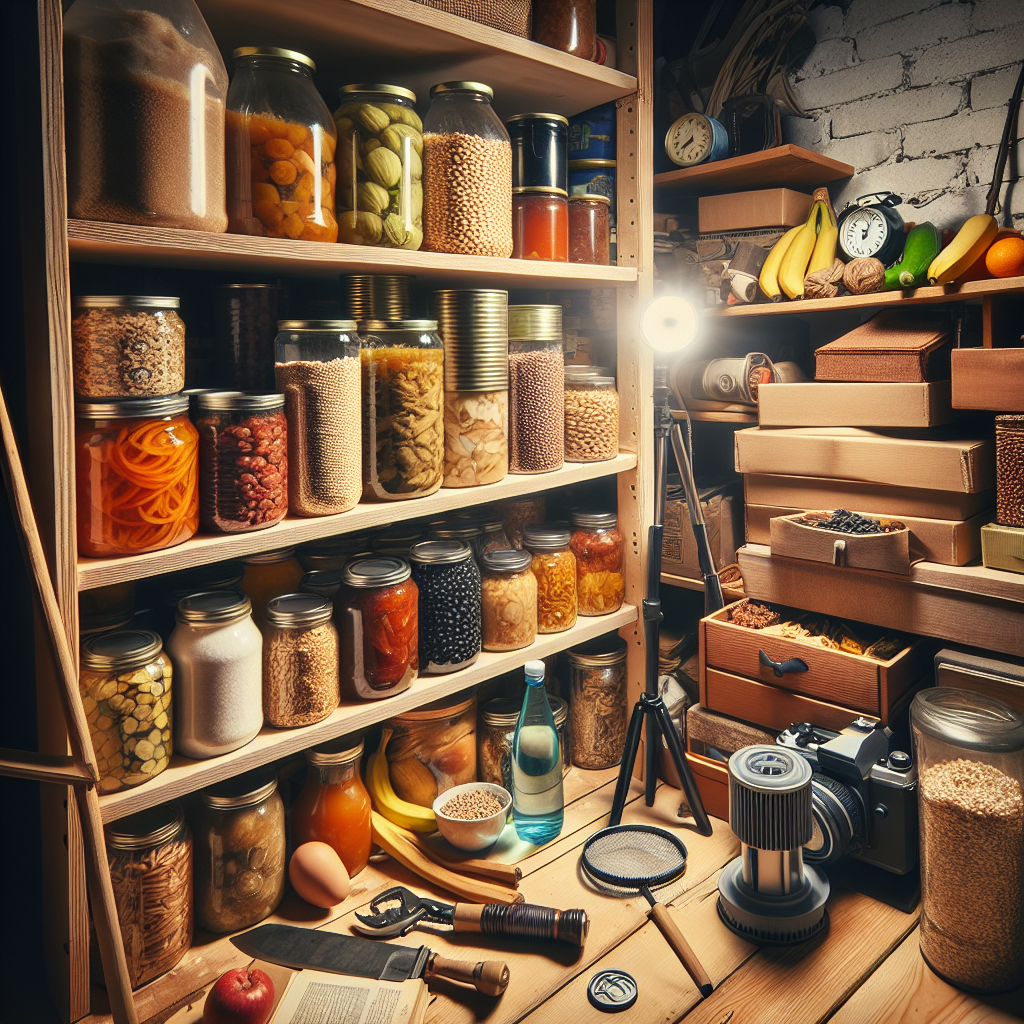
Rotating and maintaining your food stockpile
Implementing a first-in, first-out (FIFO) system
To prevent food waste and ensure the freshness of your stored food, implement a first-in, first-out (FIFO) system. This means using and consuming the oldest items in your stockpile before reaching for newer ones. When storing new supplies, place them behind existing ones to ensure the older items are used first. Regularly check expiration dates and rotate your stockpile accordingly to maintain a constant supply of fresh and usable food.
Monitoring expiration dates and food quality
Regularly monitor the expiration dates of your stored food and be mindful of the recommended shelf life of each item. Rotate and consume foods that are nearing their expiration dates to avoid waste. Additionally, regularly inspect the quality and condition of your stored food. Discard any items that show signs of spoilage, such as mold, off smells, or unusual textures. It’s crucial to maintain a vigilant eye on your stockpile to ensure the safety and quality of the food you store.
Creating a schedule for rotation and replenishment
To maintain an effective long-term food storage plan, establish a schedule for rotation and replenishment. Set reminders to review and update your inventory regularly. This ensures that you are continuously aware of what needs to be consumed, replaced, or added to your stockpile. Consider incorporating this task into your household’s routine to make it a regular part of your preparations. Utilize your existing supplies before they expire and restock accordingly to maintain a reliable food storage system.
Considering alternative storage options
Exploring different types of food preservation
While non-perishable and shelf-stable foods are the core of your long-term food storage plan, exploring alternative food preservation methods can increase your options. Consider techniques such as canning, fermenting, and pickling, which allow you to preserve fresh food items for an extended period. These methods can be used to store fruits, vegetables, meats, and other perishable items. By diversifying your food preservation techniques, you can expand the variety of foods available to you in an emergency.
Utilizing freezing and canning techniques
Freezing and canning are two common methods of food preservation that can significantly extend the shelf life of certain items. Freezing works well for fruits, vegetables, meats, and prepared meals, while canning is suitable for fruits, vegetables, jams, and sauces. Invest in quality freezer-safe containers and canning equipment to maximize the effectiveness of these preservation methods. Be sure to follow proper procedures to ensure food safety and maintain the quality of your preserved foods.
Considering freeze-dried and dehydrated foods
Freeze-dried and dehydrated foods are popular options for long-term food storage due to their extended shelf life and minimal storage requirements. These products retain their nutritional value while being lightweight and easy to store. You can find a wide range of freeze-dried and dehydrated fruits, vegetables, meats, and even complete meals. Incorporating these foods into your storage plan provides additional variety and convenience, especially in situations where access to fresh produce is limited.
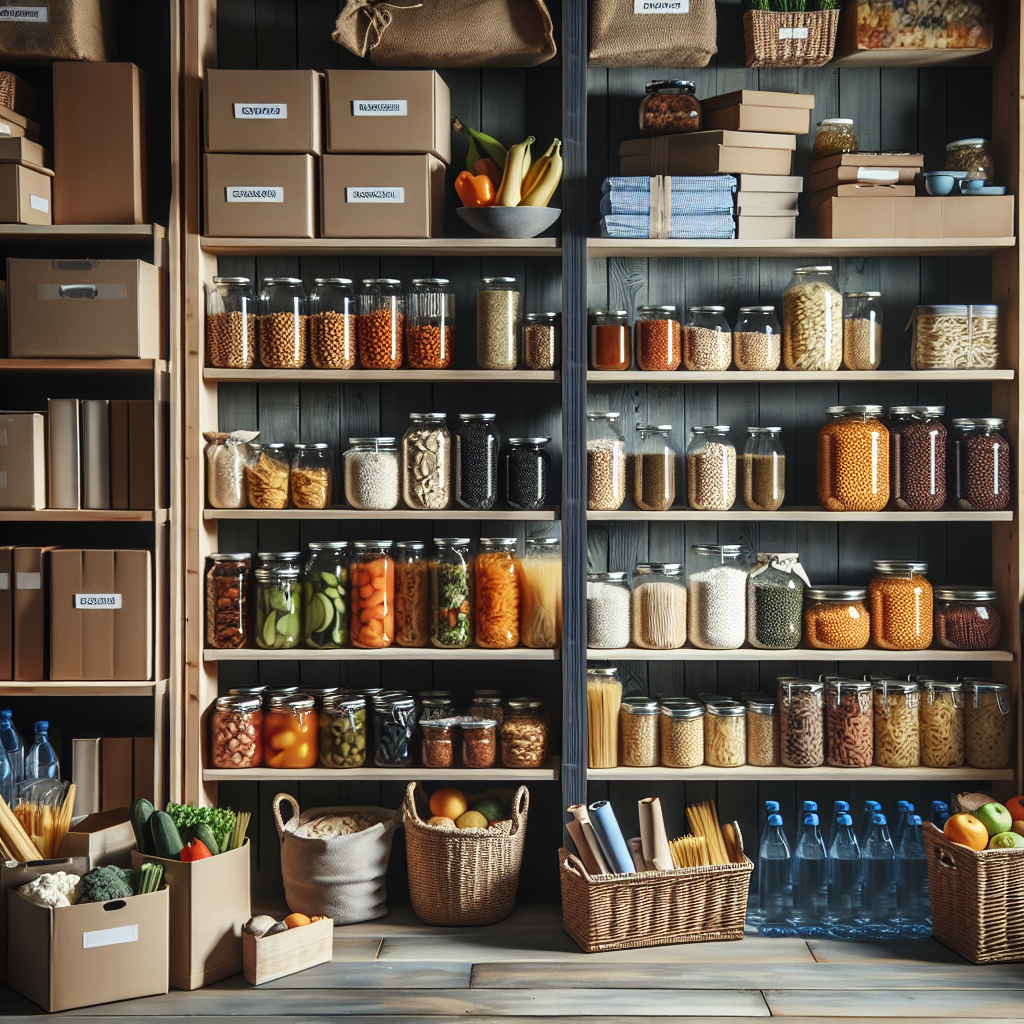
Managing water storage and purification
Determining the water needs per person
In addition to food, water is a critical component of any long-term storage plan. Calculate the daily water needs per person, taking into account factors such as age, climate, and activity level. The general guideline is to store at least one gallon of water per person per day for drinking and sanitation purposes. Keep in mind that additional water may be required for cooking, hygiene, and pets. Ensure you have an adequate supply of clean water to sustain everyone in your household during an emergency.
Storing water in safe containers
When storing water, it’s crucial to use clean, food-grade containers designed for long-term storage. Choose containers that are specifically labeled as safe for holding water. Consider using sturdy plastic jugs, collapsible water containers, or large water barrels. Avoid containers that have previously held non-food substances or chemicals, as these can contaminate the water. Store water in a cool, dark place away from direct sunlight to prevent the growth of algae or bacteria.
Implementing water purification methods
In addition to stored water, it’s essential to have a plan for purifying water from alternative sources during an emergency. Invest in a reliable water filtration system, such as a portable water filter or purification tablets, to remove impurities and make water safe for consumption. Boiling water is also an effective method for purifying it. Establishing multiple methods of water purification ensures that you can access clean and safe drinking water even when your stored supplies run low.
Building an emergency cooking and heating setup
Selecting portable cooking devices and fuel sources
In an emergency situation, having a reliable cooking setup is crucial for meal preparation and food safety. Choose portable cooking devices that are suitable for both indoor and outdoor use. Options include camping stoves, portable propane or butane stoves, and solar cookers. Consider the fuel sources required for these devices and ensure you have an adequate supply. This might include propane canisters, fuel tablets, or wood for a makeshift stove.
Setting up a safe and efficient cooking area
When setting up your cooking area, prioritize safety and efficiency. Ensure proper ventilation to prevent the buildup of harmful gases or carbon monoxide when using indoor cooking devices. Set up your cooking area in a well-ventilated space or near a window. Keep flammable materials away from the cooking area and have a fire extinguisher nearby. Create a designated cooking space with all the necessary utensils, cookware, and fuel readily accessible.
Considering alternative heating options
In addition to cooking, it’s essential to consider alternative heating options in case of a power outage or loss of central heating. Portable space heaters or kerosene heaters can provide localized heat in specific areas of your home. Ensure you have a safe supply of fuel for these devices and follow all safety guidelines to prevent accidents or carbon monoxide poisoning. Blankets, sleeping bags, and warm clothing can also help provide insulation and retain body heat in colder environments.
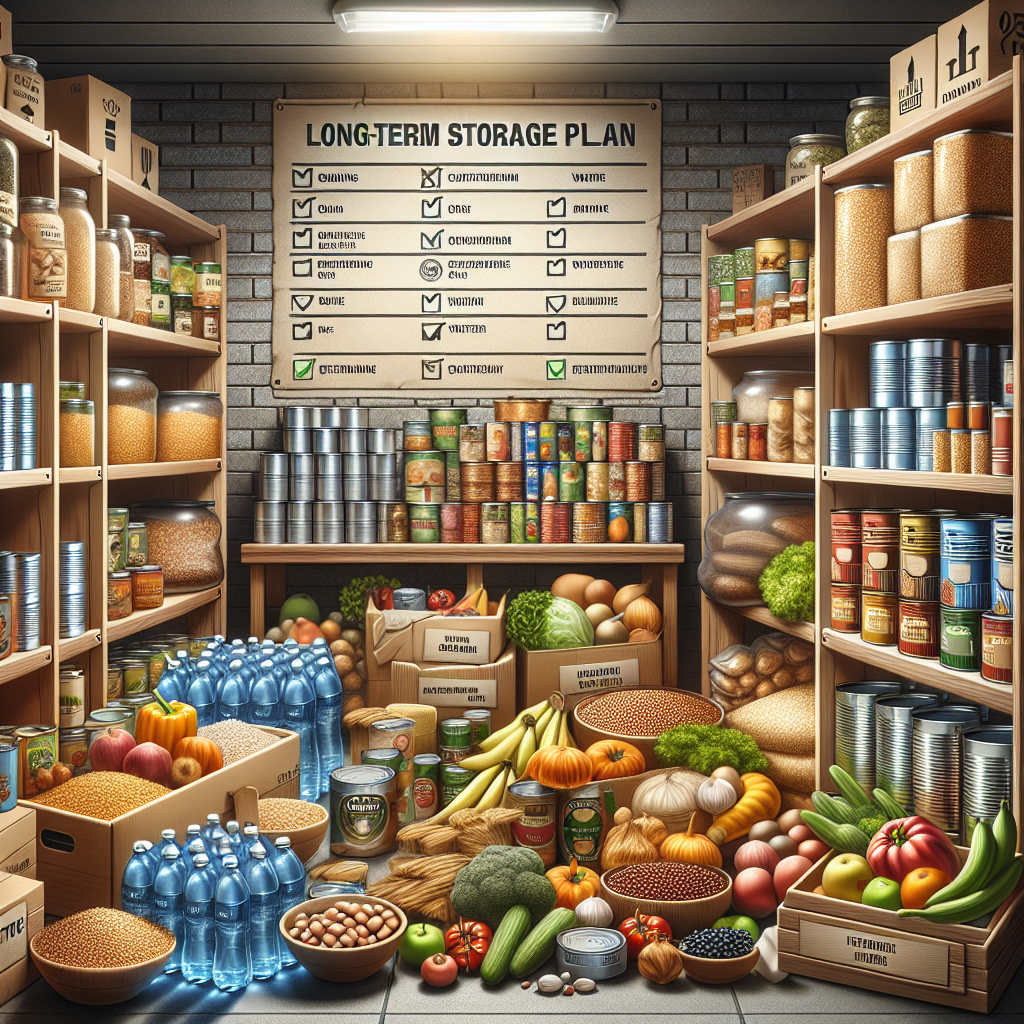
Creating a plan for sustainable food production
Establishing a garden or hydroponic system
For a comprehensive and sustainable long-term food storage plan, consider establishing a garden or hydroponic system. Growing your own fruits, vegetables, and herbs provides a fresh and renewable supply of food. Plan your garden based on the space available and the variety of crops suitable for your climate. If space is limited, hydroponic systems allow for efficient cultivation in a controlled environment, using water and nutrient solutions instead of soil.
Growing vegetables and fruits with long-term storage capabilities
When choosing crops for your garden or hydroponic system, prioritize vegetables and fruits with long-term storage capabilities. Some examples include root vegetables like potatoes, carrots, and onions, as well as winter squash, apples, and pears. These crops can be stored in cool and dry conditions for extended periods, ensuring a supply of fresh produce even when growing conditions are not optimal. Consider learning preservation techniques to further extend their shelf life.
Raising livestock or poultry for meat and eggs
For those with the available space and resources, raising livestock or poultry can provide a source of meat and eggs in addition to your stored food supply. Chickens, rabbits, and even goats are relatively low-maintenance animals that can provide a sustainable source of protein. Ensure you have the necessary infrastructure and knowledge to care for these animals properly. Remember to consider local regulations and zoning laws that may apply to livestock or poultry rearing.
Reviewing and updating your food storage plan
Evaluating and revising your inventory regularly
A long-term food storage plan should not be a one-time endeavor but an ongoing process. Regularly evaluate and revise your inventory to ensure its effectiveness and relevance. Check for any expired or soon-to-expire items and remove them from your stockpile. Consider any changes in dietary needs, preferences, or household size and adjust your plan accordingly. Engage in regular inventory reviews to maintain an accurate assessment of your resources and needs.
Adapting the plan to changing circumstances
Life circumstances can change, and your food storage plan should be adaptable to these changes. Whether it’s a new addition to the family, a change in dietary restrictions, or a shift in your living arrangements, be prepared to adjust your plan accordingly. Regularly reassess your storage space, the number of people to feed, and any specific requirements or preferences within your household. Remaining flexible and receptive to change ensures that your food storage plan remains relevant and effective.
Seeking professional advice if needed
If you feel overwhelmed or unsure about certain aspects of your food storage plan, don’t hesitate to seek professional advice. Reach out to nutritionists, emergency preparedness experts, or even experienced homesteaders who can provide guidance and expertise. These professionals can offer valuable insights tailored to your specific needs and circumstances. With their assistance, you can refine your plan and make informed decisions regarding food selection, storage methods, and sustainable practices.
In conclusion, creating a comprehensive, long-term food storage plan involves careful assessment, consideration of nutritional needs, and strategic planning. By determining your storage space, calculating the number of people to feed, accommodating dietary restrictions, and choosing the right food items, you lay a solid foundation. Additionally, accurately calculating the quantity of food needed, packaging and storing it properly, and ensuring regular rotation and replenishment are vital steps to maintain a reliable stockpile. Exploring alternative storage options, managing water storage and purification, setting up an emergency cooking and heating setup, and creating a plan for sustainable food production enhance your preparedness further. Finally, regularly reviewing and updating your food storage plan and seeking professional advice as needed ensure that your plan remains effective in changing circumstances. By following these guidelines, you can confidently build a long-term food storage plan that will help sustain you and your loved ones during emergencies or unforeseen circumstances.

